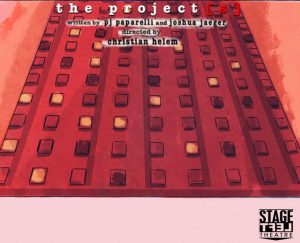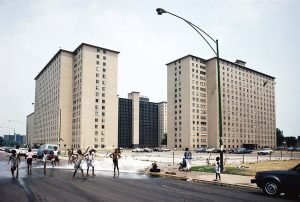
 Recommended *** The young people of Chicago, when they hear the term “projects”, are unaware of what they truly were. In fact, almost 100% of the white population never truly understood what they were. When I was a young man, I was told when one drives down Division Street, through the Cabrini-Green “projects”, make sure your windows are rolled up and your car doors are locked! We did not have air conditioning in our cars, so we were warm during the one mile drive. The projects were a way of replacing slums in neighborhoods that were mostly populated with African-American families. Not just in Chicago, but in every urban area that has a huge population of Negroes. Ida B. Welles was another”project” and one that many know of, two miles on the south side, called The Robert Taylor Homes.
Recommended *** The young people of Chicago, when they hear the term “projects”, are unaware of what they truly were. In fact, almost 100% of the white population never truly understood what they were. When I was a young man, I was told when one drives down Division Street, through the Cabrini-Green “projects”, make sure your windows are rolled up and your car doors are locked! We did not have air conditioning in our cars, so we were warm during the one mile drive. The projects were a way of replacing slums in neighborhoods that were mostly populated with African-American families. Not just in Chicago, but in every urban area that has a huge population of Negroes. Ida B. Welles was another”project” and one that many know of, two miles on the south side, called The Robert Taylor Homes.
The production that Stage Left Theatre is now presenting “online” , “the project(s)” is primarily about this neighborhood, but there are very close to the others. In the 1950’s and 1960’s, the Urban Housing Authority began to build “the project(s)”. The purpose, so they say, was to help the African-American population get out of the slums and have decent housing. This would, according to the politicians “change their lives” and make it better!
The question that is brought up in this 2 1/2 hour production written by P J Paparelli and Joshua Jaeger is, due to the Covid-19 “pandemic” , presented on a ZOOM platform, live ( not recorded). The housing project, mostly high-rise, was supposed to give these families hope. Community , instead of lone living. Management worked in the beginning and the people were happy. Music, food, family and a sort of self sustained economy as the locals had small grocery stores ( this was before White Hen and 7-11 pantry). We ( the white community) were told that this was good for the people and the city.
In this play, we get to meet the actual characters (played by a solid cast of performers) telling s the stories as THEY TRULY HAPPENED!
The stories contained in this production are from the residents’ perspective. We learn about the gangs, the treatment they were given by management, and we also learn about the fear they experienced. Was it truly their home? Or wat it in fact, a way for the city of Chicago to move all the African-Americans away from areas that were more upscale. Yes, in the beginning it was nice. Let’s face it, anything brand new, when you have lived in squalor has to be nice. But as the time goes on and the buildings start to decay while the crime increased shows that the plan was not thought out in total.
The CHA said they were making better lives for the population. In fact, they were “replacing the slums of the South Side and West Side”. Mayor Daley said he was giving them a neighborhood. What they were given was a “ghetto”. Thousands of people cammed into buildings that were not built to last forever. Gangs formed, danger lurked. When you put lots of people in a small area, you do not get a community, you end up with a place to contain those who now must survive. Many young peole died in these projects. A project is in fact “a test” and this one failed!
Directed by Christian Helem, this production is live, from the performers home, to your home with the exception of Thursday, November 26th ( this will be a recorded copy).
The cast is composed of Christopher Wayland, Shariba Rivers, Jaegan Ellison, Risha Tenae, Darren Jones, Renee Locket, Danyelle Monson and Regina Whitehead-Mays. Most of htem take on several roles as we hear the stories of those who experienced the life that was dealt to the CHA residents of “the project(s)”.
Even after the people learned to deal with what they were dealt, the city decided to make changes and take down the buildings, offering alternative housing to make them feel part of the community. Away with the old- in with the new. But they were not given the easiest opportunity to do so.The truth is the land became valuable as desire by others wanted to move into the city. These public housing people were going to be displaced, and the politicians were telling them we are going to make your lives better. The people were a ‘community”- how do you tear down a community? Many could not come back- this story explores the changes and the effects on those who lived their lives in “the project(s)”.
 You can watch this history lesson ( one you will never see in a book) on line as follows:
You can watch this history lesson ( one you will never see in a book) on line as follows:
November 13th, 14th at 7 p.m., Sunday, 11 /15 at 3 p.m.,
November 21st at 7 p.m. and on November 26th at 6 p.m. ( taped edition).
Tickets are Pay-What-What-You-Can ( suggested $20) and are available thru Stage Left www.stagelefttheatre.com . For questions, tix@stagelefttheatre.com or call 773-883-8830
This is real! These are stories about real people and their experience. This is “the rest of the story”. This is the story of “the project(s)”!
To see what others are saying, visit www.theatreinchicago.com, go to Review Round-Up and click at “the project(s)”.






More Stories
“Survivors” reviewed by Julia W. Rath
“Prayer for the French Republic” reviewed by Julia W. Rath ( and another by Paul Lisnek)
“Obliteration” reviewed by Mark Reinecke